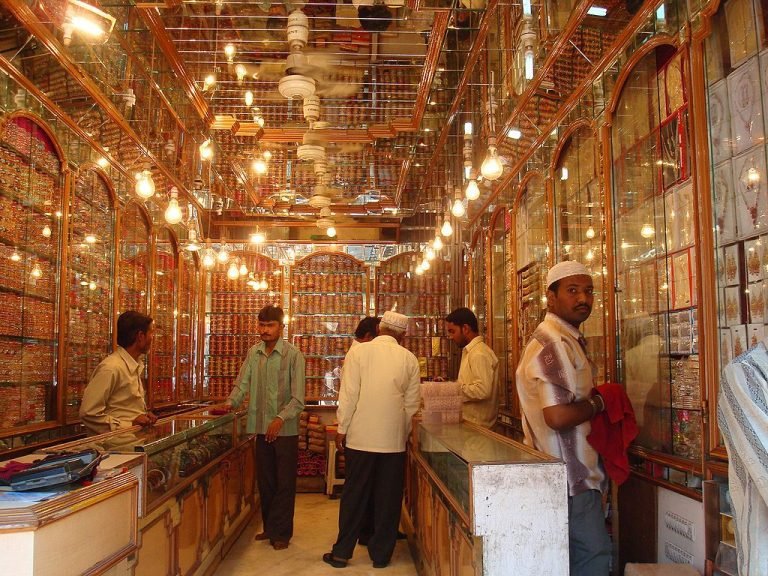Jewellery Bazaars Of India
A look into the culture, history and workings of jewellery bazaars across India provides us the unique features of each bazaar and of trade systems across regions.
India is known for its vibrant bazaar across the world. These aren’t just places to buy commodities but also sample ecosystems to experience the culture of that region. Now, when it comes to jewellery, the need for security measures and fair trade practices also come into the picture. This adds a complication to selling but also makes the workings of the bazaar extraordinary. From running a vibrant food market to prevent jewellery theft at night to selling diamonds on street markets to the most vibrant and varied jewels; there’s something that sets each market apart from the other, and are definitely worth a visit on your next bijoux shopping spree.
Zaveri Bazaar, Mumbai
From Crawford to Zaveri, South Mumbai is well known for its old markets and architecture and Zaveri Bazaar goes a notch higher when it comes to the bazaar experience with its different eras of architectural influence from Juliet balconies to elaborate white structures. The most prominent feature of this market is the gold and silver trade that it has facilitated for decades. It’s believed that the market carried 65% of the gold trade and deals in India. It is also the origin point of the biggest jewellers in India including Tribhovandas Bhimji Zaveri. The market also deals in several other luxury goods like perfumes and high-end dinner sets.
Sardar Patel Diamond Market, Ahmedabad
The only diamond market in Ahmedabad located in the Bapunagar area of the city is a crucial spot for the diamond trade. So much so that even after terrorist attacks the market opened as it was the other day because it is the hub of diamond polishing and can disrupt the cycle of the diamond industry in the region even with a single day of no work.
Mahidharpura Hira Bazaar, Surat
Mahidharpura is one of the oldest diamond markets of Surat– The hub of diamond cutting and polishing is a noteworthy diamond market, popular for bulk diamonds. It is also remarkable in terms of how it looks like a regular street bazaar dotted with simple shops, but these shops deal in diamonds instead of the usual paraphernalia of a regular market. Surat has several such markets, and Mahidharpura has the highest number of diamond units among these markets. It’s a simple market with a guarantee of authenticity. This comes from the established systems in the market for a fixed price throughout as well as systems like CVD machines, so the customers can rest assured that the diamonds are authentic.
Dilli Haat, Delhi
Dilli haat is one of the most popular markets for handicrafts from across India. Artisans from all across the country sell their goods here, making it a great place to find handicraft jewellery with both cultural and aesthetic value. Because of its strong association with handicrafts, the market is a strong centre for the promotion of food, folk dances and cultural activities. The bazaar is surrounded by several tourist attractions making it a hotspot for people across the world to buy traditional Indian jewellery.
Begum Bazaar, Hyderabad
Begum Bazaar is a 400-year-old market dealing in gold and silverware in Hyderabad established during the time of the Qutub Shahi Dynasty. Humda Begum, the wife of the then-Nawab helped establish the market, which gave the place its name. It facilitates transactions worth crores of rupees. It is located near the Qutub Minar and has narrow lanes that give the market the look and feel of a typical traditional Indian market. The highlight of the bazaar is how the space has managed to stay relevant through adaption for centuries.
Sarafa Bazaar, Indore
Sarafa Bazaar is known all over India for its combination of dazzling jewellery and mouth-watering food. The most interesting component of this bazaar is the establishment of the midnight food bazaar that opens up once the jewellery market closes. This not only allows distinct markets to utilize the same space but also gives the jewellery market security from theft throughout the night. The Sarafa Bazaar consists of shops with both contemporary and traditional jewellery and is a treat for people trying to find something unique but haven’t figured out exactly what they want. If you go with an ample amount of time at hand you can explore and discover new jewellery options.
Johari Bazaar, Jaipur
Johari Bazaar in Jaipur is known for its marvelous gems including topaz, diamonds, and emeralds. Apart from gemstones, the market is also popular for jewellery styles like Kundan, Polki, and Meenakari. It is a UNESCO world heritage site, and is said to be built to become a commercial capital. The jewellery market is exemplified by its pink burnt brick buildings, an identity for Jaipur and an element that makes the gems and jewellery market extra vibrant. The market featuring Jaipur’s traditional jewellery styles is a maximalist’s dream.
These jewellery bazaars across the country bear testimony to the country’s thriving culture. Situated in the great outdoors these bazaars are spaces to experience our culture and a different and authentic way of conducting jewellery trade. Each market has a unique feature that sets it apart from all the other markets of the country situated in street corners and lanes. These bazaars are an avenue for industrialists and traders alike to understand the consumer tastes and relevant jewellery styles of a region.







